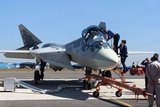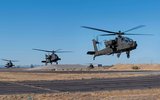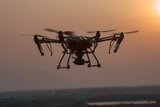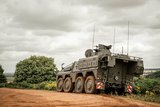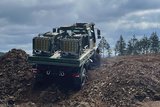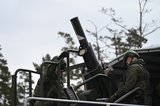Tiltrotor: The Long-Range Maneuver Solution
Enjoy free access to this sponsored article, all content provided by Bell
Operating from dispersed locations over vast distances, rapid deployment of assets and strategic positioning of forces cannot be achieved with the current rotary-wing fleet. The Future Long Range Assault Aircraft (FLRAA), the U.S. Army’s next generation of vertical lift, is a revolution in capability that enables the warfighter to maintain overmatch in an ever-changing battlefield.
As Chief of Staff of the Army, GEN Randy George stated, “The service also must make tough choices and be willing to stop buying equipment that’s old or obsolete, even if it was a requirement or a program of record.”
In response to the U.S. Army’s need for increased lethality, Bell developed the V-280 Valor demonstrator, a tiltrotor technology combining the range, speed and payload of a fixed-wing aircraft with the runaway independence of a helicopter. It can deploy on, and operate from, naval vessels, and is fully capable of self-deployment.
“The V-280 Valor’s ability to take off at short notice, with its speed, range and strategic lift deployment options increase operational flexibility for missions including utility, medevac and assault,” Frank Lazzara, Director of Sales & Strategy for FLRAA at Bell Textron Inc. explained.

With its range and speed, FLRAA enables operations from a point of relative sanctuary in dispersed locations, safe from most long-range fires and threat systems that make current assets vulnerable. Dispersion enables the commander to think differently and to employ forces from multiple locations and converge on an objective – operational flexibility.
Tiltrotors change the geometry of the battlefield, providing operational reach, responsiveness and flexibility that maneuver commanders require to employ forces at distance with speed while mitigating risk. This creates strategic unpredictability, offers operational flexibility and creates decision dilemmas for the adversary, enhancing the overall deterrence value.
The development of the V-280 Valor tech demonstrator and the U.S. Army’s FLRAA program have enabled the U.S. Army to develop Large-Scale, Long-Range Air Assault, or L2A2. L2A2’s intended objective is to deliver one Brigade Combat Team in one period of darkness, over 500 miles, arriving behind enemy lines, and conduct sustained combat operations.
In recent exercises to test L2A2, the 101st Airborne Division’s 2nd Brigade Combat Team was moved 575 miles away to the Joint Readiness Training Center (JRTC). The mission required three nights and nearly 1,000 soldiers to move the entire Brigade Combat Team under the cover of darkness.
The next part of the training was done as a simulation, this time involving the future Air Assault CAB, a formation which includes FLRAA, created to ensure the Army can conduct L2A2. The simulation results showed the brigade was able to perform the same mission in one period of darkness instead of three and reduced the logistics and security footprint by half, with only one mission support site and three Forward Arming and Refueling Points (FARPs).

The advanced tiltrotor’s transformational capability is well suited for the increased complexity of the global operating environment, thereby necessitating the need for interoperability, which is a key focus with NATO and non-NATO allies. The capability also enhances the prospects for interchangeability – a term related to interoperability that applies common sustainment practices and pooling and sharing of supply chains and logistics. It additionally could reduce cost over the long term in acquisition and sustainment.
While a tiltrotor’s speed is an inherent benefit, the inclusion of the Modular Open System Approach (MOSA) and the digital backbone truly define its sustained lethality. Warfighters can’t wait years for new capabilities to address challenges and threats of today. Nor can the closed systems of yesterday be maintained. MOSA delivers the ability to upgrade or replace obsolete components in the face of new threats or even to share components between weapon systems.
There is no other vertical lift platform in the world that can do what tiltrotors do to deliver lethal warfighting capability to the point of need. Speed enables reaction, speed increases survivability, speed and range combined enable dispersed logistical support and time-sensitive exploitation of temporary domain dominance.
Once fielded, these advanced tiltrotors will transform not only how the U.S. Army conducts basic maneuver and multi-domain operations, but also a myriad of missions that they currently are unable to conduct with the enduring fleet of conventional rotary-wing assets.
More from Industry Spotlights
-
![De-Risking the Future: Manufacturing Certainty for Unmanned Systems]()
De-Risking the Future: Manufacturing Certainty for Unmanned Systems
How strategic manufacturing partnership solves the industrialisation triad — Scale, Compliance and Cost — for hyper-growth defence tech innovators.
-
![Battlefield mobility, made in the UK]()
Battlefield mobility, made in the UK
How does Britain ensure that we can preserve the lives of our soldiers and allies – now and in the future – with homegrown innovation and resilient domestic manufacturing? At Pearson Engineering, we are proud to be a central part of the answer to this increasingly important question.
-
![Strengthening Baltic defence capabilities]()
Strengthening Baltic defence capabilities
How Latvia is bolstering its territorial defences, industrial capacity and international cooperation with Dynamit Nobel Defence’s SKORPION2 Remote Mining System.
-
![Barco’s vision to trust: from past to future]()
Barco’s vision to trust: from past to future
Barco’s story is one of constant evolution enabling more immersive, reliable, and future-ready training experiences.
-
![How are next-generation ejection seats helping pilots when they need it most?]()
How are next-generation ejection seats helping pilots when they need it most?
The ACES 5 ejection seat from RTX’s Collins Aerospace introduces new, innovative and patented technologies to help save lives.
-
How Patria TREMOS redefines battlefield mobility
The war in Ukraine has made it clear: the battlefield waits for no one. Military operations now take place in fast-paced environments, and speed is not just about the fight itself – it is about the entire ecosystem of warfare.







